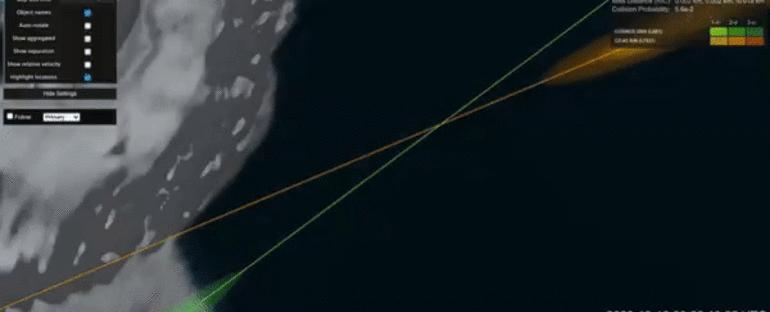For the second time this year, experts can only watch and wait as two large objects close in on a potential collision course in low-Earth orbit.
According to space debris tracking service LeoLabs, an old, discarded Chinese rocket stage and a defunct Russian military satellite are due to pass within 12 metres (40 feet) of each other on 16 October 2020 at 00:56 UTC.
There is, LeoLabs says, a greater than 10 percent chance that the two objects will collide at an altitude of 991 kilometres (616 miles) over the Weddell Sea just off the Antarctic Peninsula.
We are monitoring a very high risk conjunction between two large defunct objects in LEO. Multiple data points show miss distance <25m and Pc between 1% and 20%. Combined mass of both objects is ~2,800kg.
Object 1: 19826
Object 2: 36123
TCA: Oct 16 00:56UTC
Event altitude: 991km pic.twitter.com/6yWDx7bziw— LeoLabs, Inc. (@LeoLabs_Space) October 13, 2020
“This is probably one of the potentially worst accidental collisions that we’ve seen for a while,” space archaeologist Alice Gorman of Flinders University in Australia told ScienceAlert.
The two objects are substantial, with a combined mass of about 2,800 kilograms (6,170 pounds), travelling in opposite directions with a relative velocity of 14.7 kilometres per second (9.1 miles per second). The rocket stage is part of a Long March 4B rocket launched on 10 May 1999; after it safely transported its payload, the stage was discarded, as has been normal procedure for decades.
The satellite is a Russian Parus military satellite weighing about 825 kilograms (1,820 pounds), launched on 22 February 1989, and previously used for communication and navigation. It’s no longer operational. So neither object can be communicated with or manoeuvred to avoid a smash-up.
1/ This event continues to be very high risk and will likely stay this way through the time of closest approach. Our system generates new conjunction reports 6-8x per day on this event with new observation data each time. pic.twitter.com/d3tRbcV2P0
— LeoLabs, Inc. (@LeoLabs_Space) October 14, 2020
It’s similar to a situation earlier in the year, in which two old satellites were projected to pass within 15 to 30 metres of each other, with a one in 100 chance of collision. They later sailed harmlessly by each other like ships in the night.
In that close approach, as well as this, the chance of collision is complicated by the shape of the spacecraft. The Parus satellite has a 17-metre (56-foot) boom that could easily close the projected gap between them. But the worst case scenario would be if the two bodies collide.
There’s no risk to us here on Earth, even if the potential collision would be taking place over a densely populated region. The concern is that the two objects would create a shower of small debris. This would burn up on atmospheric entry – but it’s more likely to hang around in low-Earth orbit creating hazards for other objects up there.
“Last year, when India performed an anti-satellite test, that created about 400 cases of trackable debris. So we’d be looking at at least that number. And then of course, there’s all the small bits which aren’t trackable,” Gorman said.
“We’re not yet in a position where we can actively remove any debris like this. So it’ll be up there for a while. And because of the altitude of about 1,000 kilometres, this stuff isn’t going to reenter within a matter of weeks or months. Some of it is likely to be up there for quite some time.”
While the rate of collisions is currently quite small – in the last 10 years, they constituted just 0.83 percent of all fragmentation events in low-Earth orbit – the concern is that more serious collisions will take us rapidly down the path to Kessler Syndrome.
This was predicted by former NASA astrophysicist Donald Kessler in 1978, and it states that, with enough junk and debris in space, eventually there will be a runaway collision cascade. One collision will create hundreds or thousands of pieces of junk that will go on to collide with others, until near-Earth space is basically unusable.
“We’re not yet at that Kessler Syndrome point. But how much closer in time does this bring us to that point?” Gorman said.
“We’ll have a sudden injection of a large amount of debris that was unpredicted. And this means there’s a likelihood of other things colliding with those pieces of debris. It just makes the situation a bit more complicated.”
2/ Current risk metrics from our most recent CDMs:
Miss distance: 12 meters (+18/-12 meters)
Probability of Collision: >10%, scaled to account for large object sizes
Relative velocity: 14.7 km/s pic.twitter.com/y44QXyhHJK— LeoLabs, Inc. (@LeoLabs_Space) October 14, 2020
This, of course, is the worst case scenario; according to LeoLabs’ probability calculations it’s not likely here. But even if the two objects miss each other, it’s only a matter of time before something big does collide in near-Earth space, and we don’t currently have the ability to stop it.
This event is a grim reminder that the space debris problem, if left to its own devices, is only going to get worse. The good news is that space agencies are working towards solutions. By far the biggest generator of space debris is explosions in orbit caused by leftover fuel and batteries; space agencies and aerospace engineering companies are starting to incorporate end-of-mission planning such as defuelling in orbit to minimise those risks.
And new technologies, such as automated collision avoidance manoeuvring and space junk collection, are in the works. So we just have to hope we can continue to avoid large collisions until we have some better space junk mitigation techniques.
“My feeling about this is probably it’s not going to happen, just to be optimistic. But we’ll have to wait,” Gorman told ScienceAlert. “Let’s keep our fingers crossed.”
LeoLabs is continuing to monitor the situation. You can follow its reports on Twitter.


